Peg Herring's Blog, page 2
October 2, 2023
October Deals and Answers

Here are the answers to the High-brow Proverb quiz in the 10-1-23 newsletter. Did you get your free copy of The Dead Detective Agency? You will love Seamus!
1. Prudence and sagacity arethe worthier condiments of intrepid courage.
Discretion is the better part of valor.
2. It is fruitless to become lachrymosebecause of wasted lacteal fluid.
Don't cry over spilled milk.
3. Freedom from guile orfraud constitutes the most excellent principal of procedure.
Honesty is the best policy
4. A rotating lithoidfragment never accrues lichen.
A rolling stone gathers no moss.
5. It is not proper formendicants to be indicators of preference.
Beggars can't be choosers
6. A strong feeling ofaffection can cause the universe to rotate on its axis.
Love makes the world go 'round.
7. Folks deficient inordinary judgment scurry into areas in which celestial beings dread to setfoot.
Fools rush in where angels fear to tread.
8. Every article whichcoruscates is not fashioned of aureate metal.
All that glitters isn't gold.
9. Refrain from detonating amissile until opaque, colorless parts of the visual organs are in evidence.
Don't fire until you see the whites of their eyes.
10. Pulchritude does notextend below the surface of the dermis.
Beauty is only skin deep.
11. A beholden vessel neverexceeds 212 degrees Fahrenheit.
A watched pot never boils.
12. A feathered creatureclasped in the manual member is of equal value to a brace in nearby greenery.
A bird in the hand is worth two in the bush.
13. The question is whetherthere is any credibility to the conclusion that those with pale colored downyon the uppermost part of mammals do in reality realize more frivolity thanthose in opposite conditions.
Is it true blonds have more fun?
14. A mobile section ofpetrified matter agglomerates no bryophytes.
A rolling stone gathers no moss.
15. Desist from enumeratingyour fowl prior to their emergence from the shell.
Don't count your chickens before they hatch.
16. A plethora of culinaryspecialists has a deleterious effect upon the quality of purees, consommés, andother soluble pabula.
Too many cooks spoil the pudding (or broth).
17. A chronic disposition toinquiry deprived the domestic feline carnivorous quadruped of its vitalquality.
Curiosity killed the cat.
18. It is in the realm ofpossibility to entice an equine member of the animal kingdom to a source ofoxidized hydrogen; however, it is not possible to force him to imbibe.
You can lead a horse to water, but you can't make him drink.
19. If John persists withoutrespite in a constant, prolonged exertion of physical or intellectual effort,he will develop into a youth slow and blunted in perception and sensibility.
All work and no play makes Jack a dull boy.
20. Immediately upon theabsence of the domesticated carnivorous feline, the common house rodentsproceed to engage in sportive capers.
When the cat's away, the mice will play.
21. A round, bulging vesselmade of staves bound with hoops that is destitute of contents is productive ofthe most deafening din.
An empty barrel makes the most noise.
22. Products of ingenuity areoften the offspring of exigency.
Necessity is the mother of invention.
23. Every effort and endeavoris lawful and legitimate in endocrine affection and hostile encounter.
All's fair in love and war.
24. A copper disc secretedaway is a merited income of the same.
A penny saved is a penny earned.
25. It is suggested that onesurvey the situation before making an impetuous flight into space.
Look before you leap.
26. A reparative running bastexecuted expediently is economic protection against additional entries.
A stitch in time saves nine.
27. The printed means ofeconomic exchange is the sum underlying cause of malevolence.
Money is the root of all evil.
28. An avis settingout on a pre-dawn maneuver manages to capture an earth-burrowing crawler.
The early bird gets the worm.
29. The theological entity ofevil provides opportunity for inoperative upper manipulators.
The devil makes work for idle hands.
30. Species of homo sapienswho reside in dwellings composed of transparent crystalline rock should notengage in hurling lithoid fragments.
People who live in glass houses shouldn't throw stones.September 22, 2023
The Latest
 People often ask, "What are you working on?" Currently, I have a book in progress called Aunt Marge (possible cover above). It's women's fiction, focused on Gwen, a Chicago resident who gets herself all messed up due to a series of tragic events. Her aunt, a woman unknown to Gwen until her crises come to a head and she overdoses, offers to take her to her farm in Michigan's U.P. to recover. Gwen is grateful, but she soon figures out that Aunt Marge is no kindly soul, and there's lots going on up there that isn't exactly normal.
People often ask, "What are you working on?" Currently, I have a book in progress called Aunt Marge (possible cover above). It's women's fiction, focused on Gwen, a Chicago resident who gets herself all messed up due to a series of tragic events. Her aunt, a woman unknown to Gwen until her crises come to a head and she overdoses, offers to take her to her farm in Michigan's U.P. to recover. Gwen is grateful, but she soon figures out that Aunt Marge is no kindly soul, and there's lots going on up there that isn't exactly normal.I got the first draft back from the editor recently. She liked it but had many suggestions for improvement, and I saw that she was right in almost every instance. So that's my current goal: getting Aunt Marge in shape.
While the editor was working on that book, I started another one I'm calling Fake. I love the concept, and I managed to get a rough rough draft done before Aunt Marge came home. That one's probably a year out, but I'm looking forward to getting back to it.
Then there's my conundrum: a book I wrote some time back for YA audiences. It involves a young girl who's drawn into an oil painting, to a world where she learns how easily freedoms disappear when people don't treat each other fairly. The characters in Polly's in the Picture are fun and the world she visits has plenty of adventure, but I never knew how to present it to the world. I'm not known as a YA writer, and the amount of work it takes to break into a different writing genre is formidable. I will publish sometime soon, but I will probably depend on word of mouth for sales. There's only so much push an author can give a book, and promotion is my least favorite part of the process.
We won't even bring up Maggie Pill's next Cats & Crimes book--(Oops, I guess I did).
As usual, I have lots of things I want to get done. I have choices to make. I have covers to choose. I have edits to consider.
To be honest, I love every bit of it.
July 12, 2023
The Perks of Being a Writer

I was at an event yesterday where I saw lots of people I hadn't seen for a long time. The question that often comes up is "Are you still writing?" My answer, of course, is "Yes," but I sense that some wonder why. In twenty years, I haven't become a famous writer, and I probably never will. (FYI, I haven't become rich, either.) Why put in the hours and hours (et cetera, et cetera) it takes to write a book, edit a book, and publish a book?
I write for the same reasons anyone does what they love: crafters, bakers, amateur athletes, bird-watchers, whoever. It isn't for money or recognition; it's something they call self-fulfillment--the enjoyment of putting effort into something to get the best result you can manage.
There are some side perks to writing for publication, though, and a message I got this morning told me I'm not as crafty as I imagined. A reader who knows me well pointed out that the "bad" characters in one of my books are suspiciously similar to people I know in real life. They don't prosper in the story, so it's a bit of getting my own back. To be fair, another reader told me that a lead character I've been writing reminds her of my mother, so I guess I'm capable of writing tributes as well as take-downs.
Another side perk is making things end the way I want them to. In real life, good doesn't always prevail. We see a lot of misinformed people (and downright liars) in high positions, offering "alternative facts" that would be laughed into the dirt if their listeners weren't equally misinformed and stubbornly unwilling to do the tiniest bit of fact-checking. In a novel, I can make good things happen at the end, despite my belief that IRL,things are too far out of control for recovery.
Finally, I can escape into my books, my writing, my storytelling. The school where I used to teach is afire with controversy, and while I do what I can to inform myself and support the staff, I find it helpful--maybe critical--to come home and sink into whatever part of the writing process I'm involved in at the moment.
So am I still writing? Yes. Not famous. Not rich. But it makes me happy. What more can I ask of life?
May 20, 2023
What's So Great About Reading?
 I don't think it's too much of a stretch to say that reading has at times saved my sanity (such as it is). I admit that's not true for everyone, but readers know. I thought I'd list some reasons for championing a pastime that isn't always healthy (It's sedentary, and isolating, since we remove ourselves from the real world when we read. Cue my dad's voice: "Get your nose out of that book and do those dishes!")
I don't think it's too much of a stretch to say that reading has at times saved my sanity (such as it is). I admit that's not true for everyone, but readers know. I thought I'd list some reasons for championing a pastime that isn't always healthy (It's sedentary, and isolating, since we remove ourselves from the real world when we read. Cue my dad's voice: "Get your nose out of that book and do those dishes!")But look what I get that's positive.
I learn stuff. From the time I was a kid, I found books that taught me things. The library at school had biographies of famous people, and I discovered they were mostly just people. The encyclopedias my mom bought at the grocery store (with stamps or something similar) were filled with articles about animals, exotic places, and historical events. I recall that when my brother was born, my parents apparently thought I was too young to understand why he didn't come home from the hospital and why they spoke about him in whispers. I saw my sister reading an article in the encyclopedia, saw her put a marker in her place. When she was gone, I opened the book and learned about the RH factor, a birth problem that might have killed the little guy, the only son of an only son and therefore the last of our family name. (With blood transfusions from several "dear hearts" in our little town, he made it.)
I avoid reality. A good book can take you away from whatever is bugging you on a given day. I can remember only a few times when I couldn't sink into someone else's story far enough to forget my own.
I learn compassion. I used to explain to my students that in fiction, we enter into the heads of people who are unlike us. We experience their trials vicariously, so we are able to imagine what it must be like, or what it must have been like, to be other than what we are. I think the first time I was aware of that was when we were assigned The Good Earth in tenth grade English. Olan was real to me, and I think she awakened some spark of feminism in my soul. How could it be that a woman who worked so hard, did so much, was nothing to her husband or to her society? That brought an additional question: what does our society do to make women feel that their contributions are worthwhile? We're better than some, but read a range of materials and you'll see there's a way to go.
I question my own prejudices. I grew up in an all-white, rural area, so I had very little exposure to differences, whether religious or racial or ethnic or individual. Reading is sometimes uncomfortable, because I'm exposed to ideas unlike what my upbringing "taught" me. I recall reading Leon Uris' book, Trinity, and seeing the IRA's side of the Irish troubles. He did the same for the Palestinians with The Haj. Those were not people I'd ever heard defended: in my home town they were "terrorists" who deserved no one's time. While that might be true in part, hearing their side of the issue made them more human to me, and I learned that there was right and wrong on both sides.
I am forced to examine my own society's faults. If you read widely, you see the U.S. through other eyes. The countries or people that see us as imperialists. Those who see us as hoggish devourers of the world's resources. Those who wish we were a little less pushy and arrogant about trying to make everyone just like us. Reading tamps down the sense we're often taught in school and told by politicians that the U.S. is always the good guy. It's not always comfortable to see, but it's something we need to know.
I relax. Choice of book means a lot when it comes to my level of enjoyment. There are times when I can't bear certain subjects. I have a rough time with stories about kids in abusive families if the plot stays on it for too long. I also avoid stories that dwell on atrocities, like WWII Nazi horrors. I filled up on reading about those horrors long ago, so I don't feel a need to revisit the subject. On the other hand, I can't do too fluffy either. I mean, how many times am I supposed to wonder whether the girl will get the guy she's crazy about by the end of the book? What I tend to read are historical novels, mostly European, and mysteries. The former offer the opportunity to learn about other times, and the latter let me try to guess the killer in a situation where my being wrong doesn't mean a thing.
May 7, 2023
Drat! Another Idea

People often ask authors, "Where do your ideas comefrom?"
Answers will vary.
Ideas come from the present. The past. The news. Local gossip. Ancient stories. Out of nowhere.
I hit a kind of hiatus this week. The next Maggie Pill book is done, at least until my eagle-eyed beta readers get their hands on the author copies and make their corrections. The next Peg Herring book, tentatively called Aunt Marge, needs time to rest. I believe that, like a roast just out of the oven, a book requires "sitting time," a period where the author puts it away and thinks about something else. In a month or six weeks or whatever, it will read differently, which will bring about all kinds of tweaks and improvements. At least, that's what I preach and practice.
Those two things mean, however, that I have nothing to write at present, and nothing to edit either. I had told myself I'd concentrate on reminding readers about my older books as well as helping "Maggie" push the new one.
And then I happened to look at a folder called "Old Ideas," and there it was, a one-paragraph sketch of an story I'd had, probably while riding home from Florida in the car. Those hours of silence tend to germinate lots of "possibles" that I jot down and promptly forget when I get home, like building an audience on TikTok or taking up Tae-Bo again.
When I read over that paragraph, details starting falling into my head like raindrops. I knew what the three main characters had to be like. I knew the setting and tone. I even knew what crime they would be presented to solve. I wrote it down as fast as I could, because these things tend to slip away if they aren't nailed down. Some will be rejected later, but right now, everything is possible.
The problem with this book will be when. When will I have months to dedicate to it? Maggie's cat lady books are popular, so I should be plotting the next one. And Aunt Marge is almost ready for readers to enjoy. I can't work on two books at once--it confuses my tiny mind--but I like this idea. I'm not thrilled with putting it on the back burner again.
I'll keep you informed. When I know, you'll know.
When people ask me where my ideas come from, I tell them, "I don't really know, but I do know I will die with unwritten books in my head."
December 19, 2022
The Final Step That Never Ends
 Truth in Advertising: My hair is no longer this color!
Truth in Advertising: My hair is no longer this color!Over the last few months, I've written about how I came to self-publish and what I do in that process. Once your cover is great, your MS is perfect (we hope), and your formatting is set for whichever sites you plan to present on, there's just promo left to do...always...forever...eternally.
A person trying to make a living by writing has to promote. Those who aren't (like me) do as much as we choose. Writers understand that promoted books, (often books that aren't as good as yours) will sell, while unpromoted books mean that no one even knows you've got a new one out there.
We begin promo long before a book is available for sale. We talk about it online. We do cover reveals. We offer samples. We try to get bloggers interested enough to feature the book. We solicit reviews. Add standing on our heads and screaming, "IT'S MY NEW BOOK!" and you have some idea.

The biggest problem is that no one knows what works. Bad books often sell because advertisers convince the public they're must-reads. It's exactly the same for good books. Promotion is mysterious, but we do know that to become interested in a book, the reading public has to know it exists.
I had a traditional publisher for my first eight or nine books. They got reviewers to tout them. They publicized like mad. I got awards and kudos. The books sold well.
When I started writing as Maggie Pill, I had nobody helping. The books took off on their own, and they still outsell everything else I've written. Nobody knows why that happens and how to replicate it. Certainly not me.
My best advice is to experiment a little without spending a ton of money. Sometimes a site that puts your book up for $15 gets as much reaction as the ones charging $500. Sometimes it doesn't. (:/)
Promotion never ends. You have to remind readers of your backlist (books published a while ago) as well as notifying them about your new stuff. Most readers do NOT read a book and go, "I love this author. I'm going to go read everything she ever wrote." (I have met a few readers who do, and authors LOVE them. I myself was once the type of reader who seldom noticed the author's name. That was before Amazon online and B&N stores in the malls, when I haunted the local library looking for books they had that I hadn't yet read.)
I don't know many authors who enjoy book promotion, but remember the Marketing Rule of 7: people have to hear about something at least seven times before they finally react to it. It's why you see those same ads on TV over and over. So we blog and we advertise and we drop hints on Facebook.
And we feel like Sisyphus, climbing that hill, pushing that rock, and knowing it will all happen again tomorrow.
Oh, Merry Christmas, Happy Holidays, and Best Wishes for whatever your celebrations might be!
December 3, 2022
Self-publishing: the MS Setup

Since self-publishing has become popular, one might wonder why people still pay big bucks for books by known authors from big publishers. The answer, I believe, is quality. With a self-pubbed book, it's hard to know if you're getting junk or a gem. For example, I once bought an e-book that sounded interesting and found the whole thing center spaced. Using a segment from my latest book, I'll show you what that looked like.
“Can you tell me what happened tonight?”
Nettie’s gaze met hers. “I shot him.”
The abruptness of the admission shocked her, but Belizek recovered quickly. “I need to know why you shot him.”
The detective tried to wait out the silence that followed. In training, they were taught to let the witness, suspect, whoever, tell the story in their own way. Silence bothers people, the instructor had claimed. Because they can’t stop themselves from filling it, they reveal things they don’t intend to.
In this case, the silence went on and on, and it felt cruel to play amateur psychologist. “Who was Caleb Green?” the detective asked gently. “Why was he here in your house?”
The woman drew on her hand-rolled cigarette, and the acrid smell of cheap tobacco again stung Belizek’s nose. Stowing the lighter in her pocket with an impatient movement, Nettie Waller said, “He was my son.”
That was a crazy way to try to read a novel, and I gave up only a few pages in. Not sure what the author was thinking. A traditional publisher makes sure that reading conventions are observed, and readers like that. It's a lot like buying brand names versus store brands: some generics are as good as the big-name products, but we tend to like the assurance of quality that comes with a name we know.
There are attempts in the self-published world to showcase well-done books, like the Brag Medallion, which curates books so readers can be sure they're buying quality work. My first Maggie Pill book got their seal of approval, [image error]but they're so jammed with authors wanting to submit to them that they have to close submissions for long periods of time. Overall, a reader's best bet is to read the sample to determine if she likes the setup, the style, and the story.
Setting up a manuscript for print involves some choices on the doer's part, but awareness of publishing convention is helpful. Not center aligning your text is an easy one, but there are others. Will all your chapters start on a right-hand page? What fonts will you use? Will you allow hyphenation? Widow/orphan control? Indent paragraphs or put space between non-indented ones?
The easiest thing to do is hire someone to format for you. It's not terribly expensive, and I did it that way for a while, but as with other elements of publishing, I watched and learned what they did and how they did it. Finally I felt ready to try my own formatting.
It's kind of fun, but it's also kind of a nightmare.

I need separate files for e-books and print. E-books don't have page numbers and headings, but Amazon requires a table of contents. Draft2Digital makes that for me if I've set the MS up correctly, which is nice. Print books have headings and page numbers, so in order for them to turn out right, the chapters have to end with a Section Break as opposed to the Page Break used for e-books. Print books should have justified margins, which can create odd spacing within a line. E-books are fine with left-hand alignment.
If you're already lost, you should hire someone to format your book for you.
Here's how I do it. Once my book has been edited to a final, polished version, I start two files, one for print and one for e-books. That will become more than two, since I publish on both Amazon and D2D, but I want to wait as long as possible to subdivide, because the more files I have, the more places I have to go to correct mistakes found along the way. Amazon and D2D differ just enough that it's easier to make two e-book files and two print files. Then I fine-tune the MS to fit the requirements of each.
Print requires PDF files, and little glitches like random blank pages tend to appear in that process. It's usually something I've overlooked or done wrong that makes that happen, but it can be frustrating to find where the error is. I've learned to eliminate extra pilcrows (¶) and check those chapter endings to make sure there's only one kind of break and it's the right one. (MOffice sometimes "helps" by putting in breaks where it thinks they're required, as does my PDF file maker.) My husband has learned to just nod wisely when I come downstairs and rant about that, missing page numbers, or unsightly spaces within a line of text.
I do a LOT of proofing back and forth for each file, but luckily, both Amazon and D2D provide ways to see online how the book is going to look IRL. The last step for print is to order proof copies. I usually get 5 and pass 4 out to my eagle-eyed proofers.

They each find different things to question, but that's good. Even when they're wrong, it makes me look at the line or passage to see why. As they read, I make one more pass through myself, trying hard not to change things unless it's absolutely necessary at that late date. Once I make the corrections found in that round, I do the final proof using the online proof sections for both Amazon and D2D. Once that's done, I okay the book for publication.
It's almost a given that there will be one last correction or two that every one of us missed, but I have learned to live with that...sort of. Well, not really. Actually, not at all, but I'm trying.
November 28, 2022
Take a Step Back
 It occurs to me that I should have discussed why people choose traditional or self-publishing, so I'm going to take a step back and do that.
It occurs to me that I should have discussed why people choose traditional or self-publishing, so I'm going to take a step back and do that.When I finished my first book, there were two options for publication, traditional publishing or vanity publishing. Vanity publishing requires that an author pay for her work to be presented to the world. It's been around for centuries, and some pretty important writers started out that way, but it was definitely a no-no for "serious" writers. Traditional publishing, getting an agent, waiting for her to shop the book to publishing houses, and hoping for an offer was, at that time, the only way to get any kind of credibility.
I did it that way. It took years, but the result was good. The publisher who signed me up got me reviews from prestigious places like the Historical Novel Society and Kirkus Reviews. I was thrilled that my first review in HNS (For Macbeth's Niece), got a star, meaning the reviewer thought it rose above the ordinary.

Another thing a large publisher gets for a writer is exposure to sales outlets. Since my publisher was known for offering quality reading material to library patrons, my book description was sent to libraries all over the country. As notifications of my ensuring books continued, my name became (somewhat) familiar to librarians everywhere. (I think it was P.T. Barnum who estimated that a person has to hear something five times before they act on the information. But I don't remember for sure.) :)

Several years later, my publisher went bankrupt. I was horrified. Besides having noplace to send my newest book, they owed me thousands of dollars that I'd never see. Checking with other authors under contract with them, I found that most of them had expected no money anyway. They hadn't "sold through," meaning they'd never sold enough books to earn back their advance, (money authors are paid before publication of the book).
That's when I went indie, but those years in traditional publishing taught me a lot. I learned how books were prepared for publication (LOTS of editing; input from experienced readers, cover artists, promoters; paying attention to trends; timing releases for best exposure; and more.) I learned that authors receive way less money than people think they do (unless your name is Rowling). I learned that most books sell very few copies, most less than 100. The vast majority of authors cannot make a living on writing alone.
Indie publishing has become more acceptable these days, but because most indie writers operate outside the business of publishing, they're at a disadvantage. They don't know the secrets. They don't have the connections. They're unrealistic about what's going to happen. I had a guy ask me to help him write his query letter (a note sent to agents to convince them to look at your book). He said in the letter that he would be a successful author because he came from a large family that would all buy his books. I once overheard another hopeful author tell an agent that he had a "whole drawerful" of really good writing at home, and if she bought his current book, he'd give her access to all the rest.
I wonder if agents have to hide a chuckle or a tear when they encounter that kind of thinking.

Today there's a thriving industry that's between traditional and self publishing: small press publishing. They do the work of editing, publishing, and promoting for authors, but of course, they take a chunk of the profits. Authors need to find out if the company is legit: I've had friends who spent tons of money they shouldn't have had to, either required or enticed to by not-so-upright publishers. I worked with a couple of different small presses years ago. While mine were honest and easy to deal with, they didn't have the connections to really push sales. And sometimes they didn't know any more about how to make a book successful than I did.
I'm almost completely indie now. I hire editors (because EVERYONE should), and sometimes cover artists, though I enjoy playing with that aspect of publishing. I choose everything: the font and setup, the release date, the publicity methods, and the formats. I do not make a lot of money, but for me writing isn't about the income. After years in the business, I make choices that suit my work ethic and my expectations.
Self-publishing boils down to three things: the work you're willing/able to do to make what you offer the public correct and appealing; the money you're willing to invest; and the outside talent you'll use to fill in your weak spots. (This also requires money and work. You need to find them and you need to pay them.)
Here's a list of some things you should know before you jump into publishing.
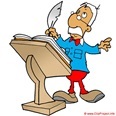
You will make less money than you expect, even if you get traditionally published. I hear that advances are shrinking and even disappearing. (My first one was $1000. No five-figure advances for most of us.)
You'll sell fewer books than you think. (See above)
Nobody is dying to discover your writing talent. Lots of writers are just as talented as you, or more so.
It's a business. Despite all the statements you hear about, "We felt compelled to share this important work with the world," the publishing business really cares mostly about sales.
Stop worrying about copyrights and secret files. Nobody will steal your story idea and sell it themselves.
People will like what you write. People will hate what you write. Some of the worst writers I've ever seen have become bestselling authors. My opinion is worth nothing.
Traditional publishing is focused on big names, so if you aren't one of those, you'll need a lot of luck to get your foot in the door.
Mid-range publishing has become gimmicky. If you get the right gimmick, you can do well. (My Sleuth Sisters books, written as Maggie Pill, are an example of an unexpected success: right mix of characters, humor, mystery=complete (but happy) surprise.
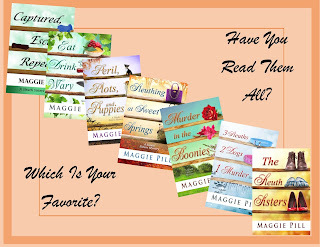
What many people do is try the agent-publisher-contract route first. If that doesn't work, they go indie. That's fine, as long as you understand that the indie, like the cheese in the children's rhyme, stands alone.
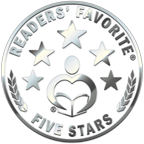 Award for Sister Saint, Sister Sinner
Award for Sister Saint, Sister Sinner
November 25, 2022
Step Three to Writing a Book: Publishing

If you decide to self-publish, there are good prospects and bad ones. It's a complicated process, though it's much simpler now than it was a few years ago. It's hard to break it down, and the learning curve is brutal at times. While I've tried to develop a schedule for myself, I find myself doing what I feel like doing on a given day and neglecting things I should be doing. That's bad, but I don't consider writing as work, so I give myself a break and do what sounds doable at the time.
Here's what I work on in the months and weeks before publication.
Cover
Manuscript setup
Publicity
Corrections
Ordering
Let's start with the cover. The easiest thing to do is hire a cover artist, and ninety percent of experts will tell you to do that. I admit that I don't have the tools, smarts, or experience that a cover artist does, but here's the thing: they don't know the material like I do.
I had a really good cover artist for the first Maggie Pill book, THE SLEUTH SISTERS. She worked with me for a few years, and watching her, I learned a lot about how the process goes. Once she made the first book cover, she used that as a theme for the ones that followed. She was fast. She was reasonably priced. She listened to what I wanted.
Then, she left the business. I did the last few covers myself, using what I'd learned from her.
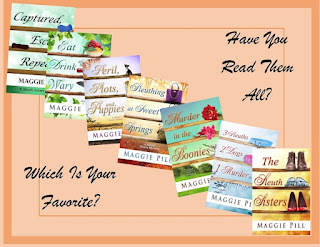
Artists work with what they're given and what they're told, and I think that overall, they do a great job. Still, I have several times received covers that made me go "What?" On my very first book cover, they used a picture of a castle that was 400 years out of date. On another, the girl looked like an android. Once, to continue a theme, they colored the woman's face green. She looked like she'd eaten bad sushi the day before.

Above is a cartoonish cover that I thought was cute when the artist sent it. I okayed it, but we found that it made people assume the book was YA. I went back to the artist to build a new cover to replace the "Scooby Doo" look. This is the one I like.

As for the others, I hated that robot-girl until I finally got the rights back and hired a new artist. And I eventually got rid of that gold-brick castle too.
All of this cost time and money, but I found that I like making my own covers. They're not as fancy as they should be, but I don't care. I learn a bit with each one, and I enjoy the process, so who am I hurting? I will say that if you want to actually make a living on your writing, hiring a cover artist is probably best. It isn't cheap, but like they say, it takes money to make money.
Pictures: If you're going to make your own covers, you will probably need to find a photo-sharing site, like AdobeStock or Photobucket. I type in what I'm thinking of for a cover pic and get hundreds of photos, some of which actually work for me. I download a few pictures (It's free, since they have their brand written across them until you pay) and play with them, to see which ones evoke the mood I'm looking for. Right now, I'm working on a story set in Michigan's UP, so I downloaded some woodsy pics and tried my lettering on them to see what I like. (So far, nothing.)
I hate that those sites make me pay a monthly fee when I really only need a few pictures a year, but some of them let me put my membership on hold, so I do.
Cover art establishes the genre and the mood, and hopefully creates the inclination to read a book. You'll find a great deal of variance in my covers, since my books are (though all in the mystery/suspense genre) very different from each other.
Here's one of my historical mysteries set in Tudor England:

Here's an oldie that I like because it's fun:
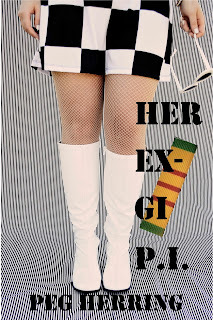
And here's a contemporary story of three sisters:
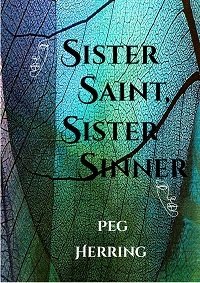
Lettering: For lettering that's not the usual Times New Roman or Arial, Google Fonts is a free site where you can download all sorts of interesting fonts. At first I got carried away there because it was fun, but my online critics soon let me know it isn't good to get too weird. (The letters dripping blood had to go.)
Publishing software: Of course, to create a cover, you need publishing software. That can get expensive, and I find a lot of it more complicated than I'm willing to work with. If I wanted something special, I'd hire it done. If I do it myself, I keep it simple and work in Publisher. Over time, I've learned tricks that help me change the look of a photo or blend elements together, eliminating the block-y or busy looks seen in some amateur covers.
Tricks: Some things you need to do a some point that will help prevent problems for you later.
* Blow the cover up really big and go over it inch by inch, inspecting every part of it to make sure edges line up, elements don't overlap, there aren't bits of forgotten text or pictures buried somewhere you can't see them, or other mistakes you've missed.
* Look for errors in punctuation/spelling at least a zillion times. (A cover artist once sent me a book with 'Someboady' on the spine. I didn't notice it for almost a year, because I only looked at the front and back.)
* Shrink the cover to thumbnail size and see if a person browsing a book-seller's site can tell what's on the cover and read the title and your name.
* Check the margins to make sure your text boxes are where they need to be. This is particularly important on the print cover, because it can look right to your eyeball when it isn't really centered on the back. More than once I've ordered advance copies and found they just didn't look right. (Which is one good reason we order advance copies!)
Cover submission: The most frustrating part of designing a cover for me is making a print cover that works for my two publishers, Amazon and Draft2Digital. They have different methods, different sizes, different responses to something that isn't working, and I sometimes spend days trying to figure out what the heck they don't like about what I submitted. Part of the reason is that each book's spine is different, depending on the number of pages. That means I can't just set up dimensions and go on; I have to work to make it fit. It requires a PDF file (which has its own quirks), so it's time-consuming to make the file, try it, and get rejected multiple times. This is where hiring of an artist is most valuable to me, because they know what they're doing and I don't, but I've learned to embrace the headaches and keep trying until the cover is accepted.
Versions: When I build a cover, I need at least five versions: print for Amazon, print for D2D, e-book in a regular file size (for sharing on FB or other social sites), e-book in a big file size (for advertisers, etc.), and audio. Each of those should be saved on a hard drive or in the cloud, clearly marked, so you can find it when you need it. Changing anything might mean you have to change all the versions, so it's best to make sure the original is right before you go on to create the others.
Timing: I like to make the e-book cover early on, because I use it to stir interest. The good thing is that it can change if I see a need. I decided with my newest Maggie Pill to add "Author of the Sleuth Sisters Mysteries," since that's kind of what Maggie is known for. With just that first file, I can easily add something or make it better in some way. Other covers come as I need them, with audio usually being last.
Testing: My first tester for covers is my husband. He has no interest in the type of books I write, so he reacts purely on a gut level: Does the cover grab a person's attention? Is its purpose clear? Is there something that distracts because it's odd or out of place?
Next I test my covers here and on Facebook, my go-to social media site. Readers are great about chiming in to praise or offer suggestions, and I appreciate that, acknowledging that I have very little in the way of raw artistic talent. It can be frustrating when half say they love Cover A and half vote for Cover B, but even that says to me that there isn't enough difference between the two to fuss about.
Of course, the acid test of a cover is the buying public. Authors would love a way to find out if a cover influences purchase, but as far as I know, Amazon hasn't yet come up with an algorithm for that.
Steps to Self-publishing

If you decide to self-publish, there are good prospects and bad ones. It's a complicated process, though it's much simpler now than it was a few years ago. It's hard to break it down, and the learning curve is brutal at times. While I've tried to develop a schedule for myself, I find myself doing what I feel like doing on a given day and neglecting things I should be doing. That's bad, but I don't consider writing as work, so I give myself a break and do what sounds doable at the time.
Here's what I work on in the months and weeks before publication.
Cover
Manuscript setup
Publicity
Corrections
Ordering
Let's start with the cover. The easiest thing to do is hire a cover artist, and ninety percent of experts will tell you to do that. I admit that I don't have the tools, smarts, or experience that a cover artist does, but here's the thing: they don't know the material like I do.
I had a really good cover artist for the first Maggie Pill book, THE SLEUTH SISTERS. She worked with me for a few years, and watching her, I learned a lot about how the process goes. Once she made the first book cover, she used that as a theme for the ones that followed. She was fast. She was reasonably priced. She listened to what I wanted.
Then, she left the business. I did the last few covers myself, using what I'd learned from her.

Artists work with what they're given and what they're told, and I think that overall, they do a great job. Still, I have several times received covers that made me go "What?" On my very first book cover, they used a picture of a castle that was 400 years out of date. On another, the girl looked like an android. Once, to continue a theme, they colored the woman's face green. She looked like she'd eaten bad sushi the day before.

Above is a cartoonish cover that I thought was cute when the artist sent it. I okayed it, but we found that it made people assume the book was YA. I went back to the artist to build a new cover to replace the "Scooby Doo" look. This is the one I like.

As for the others, I hated that robot-girl until I finally got the rights back and hired a new artist. And I eventually got rid of that gold-brick castle too.
All of this cost time and money, but I found that I like making my own covers. They're not as fancy as they should be, but I don't care. I learn a bit with each one, and I enjoy the process, so who am I hurting? I will say that if you want to actually make a living on your writing, hiring a cover artist is probably best. It isn't cheap, but like they say, it takes money to make money.
Pictures: If you're going to make your own covers, you will probably need to find a photo-sharing site, like AdobeStock or Photobucket. I type in what I'm thinking of for a cover pic and get hundreds of photos, some of which actually work for me. I download a few pictures (It's free, since they have their brand written across them until you pay) and play with them, to see which ones evoke the mood I'm looking for. Right now, I'm working on a story set in Michigan's UP, so I downloaded some woodsy pics and tried my lettering on them to see what I like. (So far, nothing.)
I hate that those sites make me pay a monthly fee when I really only need a few pictures a year, but some of them let me put my membership on hold, so I do.
Cover art establishes the genre and the mood, and hopefully creates the inclination to read a book. You'll find a great deal of variance in my covers, since my books are (though all in the mystery/suspense genre) very different from each other.
Here's one of my historical mysteries set in Tudor England:

Here's an oldie that I like because it's fun:

And here's a contemporary story of three sisters:

Lettering: For lettering that's not the usual Times New Roman or Arial, Google Fonts is a free site where you can download all sorts of interesting fonts. At first I got carried away there because it was fun, but my online critics soon let me know it isn't good to get too weird. (The letters dripping blood had to go.)
Publishing software: Of course, to create a cover, you need publishing software. That can get expensive, and I find a lot of it more complicated than I'm willing to work with. If I wanted something special, I'd hire it done. If I do it myself, I keep it simple and work in Publisher. Over time, I've learned tricks that help me change the look of a photo or blend elements together, eliminating the block-y or busy looks seen in some amateur covers.
Tricks: Some things you need to do a some point that will help prevent problems for you later.
* Blow the cover up really big and go over it inch by inch, inspecting every part of it to make sure edges line up, elements don't overlap, there aren't bits of forgotten text or pictures buried somewhere you can't see them, or other mistakes you've missed.
* Look for errors in punctuation/spelling at least a zillion times. (A cover artist once sent me a book with 'Someboady' on the spine. I didn't notice it for almost a year, because I only looked at the front and back.)
* Shrink the cover to thumbnail size and see if a person browsing a book-seller's site can tell what's on the cover and read the title and your name.
* Check the margins to make sure your text boxes are where they need to be. This is particularly important on the print cover, because it can look right to your eyeball when it isn't really centered on the back. More than once I've ordered advance copies and found they just didn't look right. (Which is one good reason we order advance copies!)
Cover submission: The most frustrating part of designing a cover for me is making a print cover that works for my two publishers, Amazon and Draft2Digital. They have different methods, different sizes, different responses to something that isn't working, and I sometimes spend days trying to figure out what the heck they don't like about what I submitted. Part of the reason is that each book's spine is different, depending on the number of pages. That means I can't just set up dimensions and go on; I have to work to make it fit. It requires a PDF file (which has its own quirks), so it's time-consuming to make the file, try it, and get rejected multiple times. This is where hiring of an artist is most valuable to me, because they know what they're doing and I don't, but I've learned to embrace the headaches and keep trying until the cover is accepted.
Versions: When I build a cover, I need at least five versions: print for Amazon, print for D2D, e-book in a regular file size (for sharing on FB or other social sites), e-book in a big file size (for advertisers, etc.), and audio. Each of those should be saved on a hard drive or in the cloud, clearly marked, so you can find it when you need it. Changing anything might mean you have to change all the versions, so it's best to make sure the original is right before you go on to create the others.
Timing: I like to make the e-book cover early on, because I use it to stir interest. The good thing is that it can change if I see a need. I decided with my newest Maggie Pill to add "Author of the Sleuth Sisters Mysteries," since that's kind of what Maggie is known for. With just that first file, I can easily add something or make it better in some way. Other covers come as I need them, with audio usually being last.
Testing: My first tester for covers is my husband. He has no interest in the type of books I write, so he reacts purely on a gut level: Does the cover grab a person's attention? Is its purpose clear? Is there something that distracts because it's odd or out of place?
Next I test my covers here and on Facebook, my go-to social media site. Readers are great about chiming in to praise or offer suggestions, and I appreciate that, acknowledging that I have very little in the way of raw artistic talent. It can be frustrating when half say they love Cover A and half vote for Cover B, but even that says to me that there isn't enough difference between the two to fuss about.
Of course, the acid test of a cover is the buying public. Authors would love a way to find out if a cover influences purchase, but as far as I know, Amazon hasn't yet come up with an algorithm for that.



